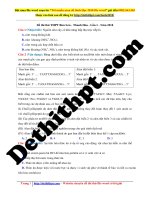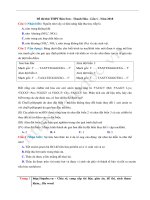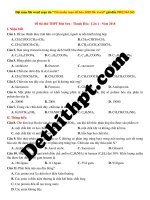Tải Đề thi thử THPT Quốc gia môn Tiếng Anh năm 2016 trường THPT Bỉm Sơn, Thanh Hóa (Lần 1) - Đề thi thử đại học môn Tiếng Anh có đáp án
Bạn đang xem bản rút gọn của tài liệu. Xem và tải ngay bản đầy đủ của tài liệu tại đây (138.3 KB, 7 trang )
<span class='text_page_counter'>(1)</span><div class='page_container' data-page=1>
Sở Giáo dục - Đào tạo Thanh Hố
Trường THPT Bỉm Sơn
ĐỀ THI THỬ THPT Q́C GIA LẦN I NĂM HỌC 2015 – 2016
<i><b>Môn: Tiếng Anh </b></i>
<i><b> Thời gian làm bài: 90 phút, không kể thời gian phát đề</b></i>
<i><b>(Đề này gồm 06 trang)</b></i>
<b>Mã đề thi 132</b>
<b>Họ, tên thí sinh:...</b>
<b>Số báo danh:...</b>
<b>SECTION A (8 points):</b>
<i><b>Mark the letter A, B, C, or D on your answer sheet to indicate the words whose pronunciation is</b></i>
<i><b>different from the others in each of the following questions. </b></i>
<b>Question 1: A. works</b> B. stops C. washes D. speaks
<b>Question 2. A. amount</b> B. astound C. mouthful D. shoulder
<i><b>Mark the letter A, B</b><b>,</b><b> C, or D on your answer sheet to indicate the word that differs from the rest in </b></i>
<i><b>the position of the main stress in each of the following questions.</b></i>
<b>Question 3. A. apply</b> B. visit C. appear D. attend
<b>Question 4. A. curriculum </b> B. kindergarten C. contaminate D.conventional
<b>Question 5. A. suspicious</b> B. marvellous C. physical D. argument
<i><b>Mark the letter A, B, C or D on your answer sheet to indicate the correct answer that best completes </b></i>
<i><b>each unfinished sentence.</b></i>
<b>Question 6. This is a valuable ... chair which dates back to the eighteeth century.</b>
A. traditional B. old-fashioned C. antique D. ancient
<b>Question 7. Look! The yard is wet. It______ last night.</b>
A. must have rained B. couldn't have rained
C. must rain D. should have rained
<b>Question 8. Last year she earned _______ her brother.</b>
A. twice as much as B. twice more than
C. twice as many as <b>D. twice as more as </b>
<b>Question 9. The girls and flowers ______ he painted were vivid.</b>
A. whose B. that C. which D. who
<b> Question 10. When his alarm went off, he shut it off and slept for ________15 minutes. </b>
A. other B. others C. another D. the others
<b>Question 11. Is it necessary that I _____ here tomorrow?</b>
A. am being B. were C. be D. would be
<b>Question 12. I saw him hiding something in a_______ bag.</b>
A. small plastic black B. black small plastic
C. small black plastic D. plastic small black
<b>Question 13.This is the __________spot on which the first pilgrims landed in America.</b>
A. historic B. historical C. history D. historicity
<b>Question 14. She earned a degree in Physics and went on _________ another degree in Mathematics.</b>
A. taking B. to take C. taken D. being taken
<b>Question 15. Those trousers are far too big. Why don’t you have them___?</b>
A. taken on B. taken in C. taken over D. taken out
<b>Question 16. So little_______about mathematics that the lecture was completely beyond me.</b>
A. I have known B. I knew C. do I know D. did I know
<b>Question 17. I gave the waiter a $50 note and waited for my _________.</b>
A. change B. supply C. cash D. cost
</div>
<span class='text_page_counter'>(2)</span><div class='page_container' data-page=2>
A. in terms of B. by means of C. with a view to D. in view of
<b> Question 19. Van Gogh suffered from depression ______ by overwork and ill-health.</b>
A. brought on B. coming about C. taken up D. pull through
<b>Question 20. He had spent ____________ time writing an essay on his childhood.</b>
A. a few B. a large number of C. a great deal of D. many
<b>Question 21. ________he study harder, he will do better in the exam.</b>
A. Should B. If C. When D. Unless
<b>Question 22. When there are small children around, it is better to put breakable ornaments out of </b>
_________.
A. reach B. hand C. place D. hold
<b>Question 23. Harry:" ______________" </b>
Kate: "Yes. I'd like to buy a computer."
A. Do you look for something? B. Good morning. Can I help you?
C. Excuse me. Do you want to buy it? D. Can you help me buy something?
<i><b>Question 24. Tom: “ Sorry, I forgot to phone you last night.” - Mary: “________”</b></i>
A. I have nothing to tell you. B. Oh. Poor me!
C. Never mind! D. You was absent - minded.
<i><b> Mark the letter A, B, C, or D on your answer sheet to indicate the word(s) CLOSEST in meaning </b></i>
<i><b>to the underlined word(s) in each of the following questions. </b></i>
<b>Question 25. Whenever Susan invites us to dinner, she customarily prepares a lot of delicious food.</b>
A. naturally B. necessarily C. usually D. certainly
<b>Question 26. It is hoped that illiteracy will soon be eradicated in our country as more and more people </b>
<b>are struggling against it.</b>
A. evolving B. plunging C. starting D. striving
<i><b>Question 27. His new yatch is certainly an ostentatious display of his wealth. </b></i>
<i><b>A. beautiful </b></i> B. showy C. large D. expensive
<i><b>Mark the letter A, B, C, or D on your answer sheet to indicate the underlined part that needs </b></i>
<i><b>correction in each of the following questions. </b></i>
<b>Question 28. After writing it, the essay must be duplicated by the student himself and handed in to the</b>
A B C
department secretary before the end of the month.
D
<b>Question 29. All of the cities in Texas, San Antonio is probably the most picturesque.</b>
A B C D
<b>Question 30. My cousin composes not only the music, but also sings the songs for the maior </b>
A B C D
Broadway musicals.
<b>Question 31. The Indians of the southwestern United States are famous for their beautiful</b>
A
art work, especially handmade jewelry cast from silver, carved from stones, or decorations with
B C D
beads and feathers.
<b>Question 32. Although no country has exactly the same folk music as those of any other, it is </b>
A B
significant that similar songs exist among widely separated people.
C D
<i><b> Read the following passage and mark the letter A, B, C, or D on your answer sheet to indicate the </b></i>
<i><b>correct word or phrase that best fits each of the numbered blanks from 33 to 42. </b></i>
</div>
<span class='text_page_counter'>(3)</span><div class='page_container' data-page=3>
Earth is the only place we know of in the universe that can support human life. (33) ______
human activities are making the planet less fit to live on. As the western world carries on consuming
(34)_______ of the world's resources while half of the world's population do so just to stay
(35)_______ we are rapidly destroying the only resource we have (36)________ which all people can
survive and prosper. Everywhere fertile soil is (37)______ built on or washed into the sea. Renewable
resources are exploited so much that they will never be able to recover (38)______. We discharge
pollutants into the atmosphere without any thought of the consequences. As a (39)______, the planet's
ability to support people is being reduced at the very time when rising human numbers and
consumption are making increasingly heavy demands on it.
The Earth's (40)______ resources are there for us to use. We need food, water, air, energy,
medicines, warmth, shelter and minerals to (41)______ us fed, comfortable, healthy and active. If we
are sensible in how we use the resources they will last indefinitely. But if we use them wastefully and
excessively they will soon (42)_______ and everyone will suffer.
<b>Question 33: A. Still </b> <b>B. Despite C. Yet D. Although</b>
<b>Question 34: A. two-thirds B. two- third C. two-three D. two-threes</b>
<b>Question 35: A. survival B. alive C. existent D. live</b>
<b>Question 36: A. on B. at C. in D. by</b>
<b>Question 37: A. sooner </b> B. rather C. either D. neither
<b>Question 38: A. completely </b> B. quite C. greatly D. utterly
<b>Question 39: A. result </b> B. product C. development D. reaction
<b>Question 40: A. natural </b> B. real C. living D. genuine
<b>Question 41: A. stay </b> B. keep C. maintain D. hold
<b>Question 42: A. run out B. run away C. run up D. run off</b>
<i><b>Mark the letter A, B, C, or D on your answer sheet to indicate the word(s) OPPOSITE in meaning </b></i>
<i><b>to the underlined word(s) in each of the following questions.</b></i>
<b>Question 43: The aircraft carrier is indispensable in naval operations against sea or shore based </b>
enemies.
A. unique B. novel C. unnecessary D. exotic
<b>Question 44. This shouldn’t be too taxing for you.</b>
A. comfortable B. demanding C. easy D. relaxing
<i><b> Read the following passage and mark the letter A, B, C, or D on your answer sheet to indicate the </b></i>
<i><b>correct answer to each of the questions from 45 to 54. </b></i>
Basic to any understanding of Canada in the 20 years after the Second World War is the country’s
<i><b>impressive population growth. For every three Canadians in 1945, there were over five in 1966. In</b></i>
<i><b>September 1966 Canada’s population passed the 20 million mark. Most of his surging growth came</b></i>
from natural increase. The depression of the 1930’s and the war had held back marriages, and the
catching-up process began after 1945. The baby boom continued through the decade of the 1950’s,
producing a population increase of nearly fifteen percent in the five years from 1951 to 1956. This rate
of increase had been exceeded only once before settle. Undoubtedly, the good economic conditions of
<i><b>the 1950’s supported a growth in the population, but the expansion also derived from a trend toward</b></i>
earlier marriages and an increase in the average size of families. In 1957 the Canadian birth rate stood
at 28 per thousand, one of the highest in the world.
</div>
<span class='text_page_counter'>(4)</span><div class='page_container' data-page=4>
Although the growth in Canada’s population had slowed down by 1966 (the increase in the first
half of the 1960’s was only nine percent), another large population wave was coming over the horizon.
It would be composed of the children who were born during the period of the high birth rate prior to
1957.
<b>Question 45. What does the passage mainly discuss?</b>
A. Educational changes in Canadian society. B. Canada during the Second World War.
C. Population trends in postwar Canada. D. Standards of living in Canada.
<b>Question 46. According to the passage, when did Canada’s baby boom begin?</b>
A. In the decade after 1911 B. After 1945
C. During the depression of the 1930’s D. In 1966
<i><b>Question 47. The word “five” in line 2 refers to__________.</b></i>
A. Canadians B. years C. decades D. marriages
<i><b>Question 48. The word “surging” in line 3 is closest in meaning to__________.</b></i>
A. new B. extra C. accelerating D. surprising
<b>Question 49. The author suggests that in Canada during the 1950’s____.</b>
A. the urban population decreased rapidly B. fewer people married
C. economic conditions were poor D. the birth rate was very high
<i><b>Question 50. The word “trend” in line 8 is closest in meaning to__________.</b></i>
A. tendency B. aim C. growth D. directive
<i><b>Question 51. The word “peak” in line 11 is closest in meaning to___________.</b></i>
A. pointed B. dismal C. mountain D. maximum
<b>Question 52. When was the birth rate in Canada at its lowest postwar level?</b>
A. 1966 B. 1957 C. 1956 D. 1951
<b>Question 53. The author mentions all of the following as causes of declines in population growth after </b>
1957 EXCEPT__________.
A. people being better educated B. people getting married earlier
C. better standards of living D. couples buying houses
<b>Question 54. It can be inferred from the passage that before the Industrial Revolution _________.</b>
A. families were larger B. population statistics were unreliable
C. the population grew steadily. D. economic conditions were bad
<i><b>Read the following passage and mark the letter A, B, C, or D on your answer sheet to indicate the </b></i>
<i><b>correct answer to each of the questions from 55 to 64.</b></i>
Ethology is concerned with the study of adaptive, or survival, value of behavior and its
Evolutionary history. Ethological theory began to be applied to research on children in the1960’s but
has become even more influential today. The origins of ethology can be traced to the work of Darwin.
<i><b>Its modern foundations were laid by two European zoologists, Konrad Lorenz and Niko Tinbergen.</b></i>
</div>
<span class='text_page_counter'>(5)</span><div class='page_container' data-page=5>
Inspired by observations of imprinting, in 1969 the British psychoanalyst John Bowlby applied
<i><b>ethological theory to the understanding of the relationship between an infant and its parents. He argued</b></i>
that attachment behaviors of babies, such as smiling, babbling, grasping, and crying, are built-in social
signals that encourage the parents to approach, care for, and interact with the baby. By keeping a
parent near, these behaviors help ensure that the baby will be fed, protected from danger, and provided
with the stimulation and affection necessary for healthy growth. The development of attachment in
human infants is a lengthy process involving changes in psychological structures that lead to a deep
<i><b>affectional tie between parent and baby.</b></i>
<b>Question 55: What was Darwin’s contribution to ethology?</b>
A. Darwin was the first person to apply ethological theory to children.
B. Darwin’s work provided the basis for ethology.
C. Darwin was the professor who taught Lorenz and Tinbergen.
D. Darwin improved on the original principles of ethology.
<i><b>Question 56: The word “foundations” in line 4 is closest in meaning to______.</b></i>
A. institutions B. inventions C. discoveries D. researches
<i><b>Question 57: The word “ensures” in line 7 is closest in meaning to __________.</b></i>
A. assumes B. guarantees C. proves D. teaches
<b>Question 58: According to the passage, if a mother goose is not present during the time period when</b>
imprinting takes place, which of the following will most likely occur?
A. The mother will later imprint on the gosling.
B. The gosling may not find a mate when it matures.
C. The gosling will not imprint on any object.
D. The gosling may imprint on another object.
<i><b>Question 59: The word “He” in line 19 refers to __________.</b></i>
A. an infant B. a psychoanalyst C. parent D. a baby
<i><b>Question 60: The word “acquire” in line 12 is closest in meaning to __________.</b></i>
A. gain B. reach C. have D. work
<b>Question 61: The author mentions all of the following as attachment behaviors of human infants </b>
EXCEPT__________.
A. smiling B. crying C. eating D. grasping
<b>Question 62: According to the passage, attachment behaviors of infants are intended to___________.</b>
A. prepare the infant to cope with separation
B. provide the infant with a means of self-stimulation
C. allow the infant to become imprinted on objects that resemble the parent
D. get the physical, emotional and social needs of the infant met
<i><b>Question 63: The phrase “affectional tie” in line 24 is closest in meaning to _________.</b></i>
A. behavioral change B. psychological need
C. cognitive development D. emotional attachment
<b>Question 64: It can be inferred from the passage that ethological theory assumes that __________.</b>
A. failure to imprint has no influence on intelligence
B. to learn about human behavior only human subjects should be studied
C. there are similarities between animal and human behavior
D. the notion of critical periods applies only to animals
<b>SECTION B (2 points):</b>
<i><b>I.Finish each of the following sentences in such a way that it means the same as the sentence </b></i>
<i><b>printed before it.Write your answers on your answer sheet.(0.5points)</b></i>
</div>
<span class='text_page_counter'>(6)</span><div class='page_container' data-page=6>
<i><b>Question 2: Mary started learning English 3 years ago.</b></i>
Mary has ...
<i><b>Question 3: Mr. Smith knew little about the Internet, so he didn’t invest into any computer companies.</b></i>
Had ...
<b>Question 4: We can’t have breakfast in the garden because it is very cold.</b>
It is so ...
<b>Question 5: Immediately after his arrival, things went wrong.</b>
Hardly ...
<i><b>II. In about 140 words, write a paragraph about the benefits of playing sports. Write your </b></i>
<i><b>paragraph on your answer sheet.(1,5 points).</b></i>
The following prompts might be helpful to you.
<i> - Keeping fit and healthy</i>
<i> - Entertaining and relaxing</i>
<i> - Earning money</i>
- THE END
<b>---ĐÁP ÁN</b>
1. C
2. D
3. B
4. B
5. A
6. C
7. A
8. A
9. B
10. C
11. C
12. C
13. A
14. B
15. B
16. D
17. A
18. C
19. A
20. C
21. A
22. A
23. B
24. C
25. C
26. D
27. B
28. A
29. A
30. A
31. D
32. B
33. C
34. A
35. B
36. D
37. C
38. A
39. A
40. A
41. B
42. A
43. C
44. C
45. C
46. B
47. A
48. C
49. D
50. A
51. D
52. A
53. B
54. A
55. B
56. A
57. B
58. D
59. B
60. A
61. C
62. D
63. D
64. C
<b>SECTION B (2 points):</b>
I. Finish each of the following sentences in such a way that it means the same as the sentence printed
<b>before it.Write your answers on your answer sheet. (0.5points)</b>
</div>
<span class='text_page_counter'>(7)</span><div class='page_container' data-page=7>
<b>Question 3: Had Mr. Smith known much about the Internet, he would have invested into some </b>
computer companies.
<b>Question 4: It is so cold that we can’t have breakfast in the garden.</b>
<b>Question 5: Hardly had he arrived when things went wrong.</b>
<b>II. In about 140 words, write a paragraph about the benefits of playing sports. Write your </b>
<b>paragraph on your answer sheet. (1,5 points).</b>
- Viết đúng format: 0,4 điểm (đúng cấu trúc đoạn văn
- Nội dung: 0,5 điểm, phát triển y
- Từ vựng cấu trúc, từ nối: 0,3 điểm
</div>
<!--links-->









